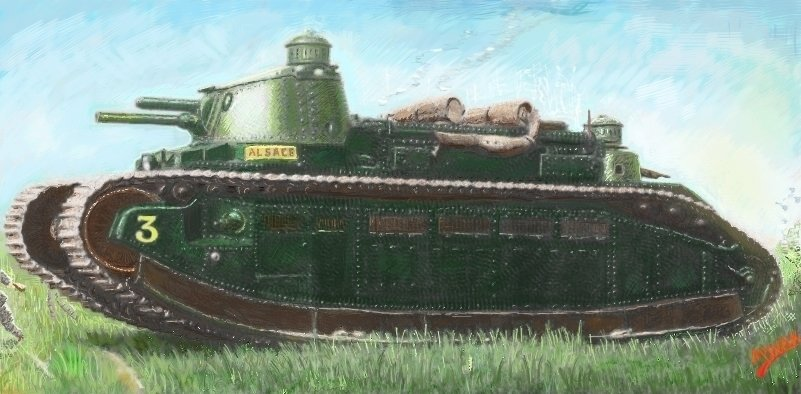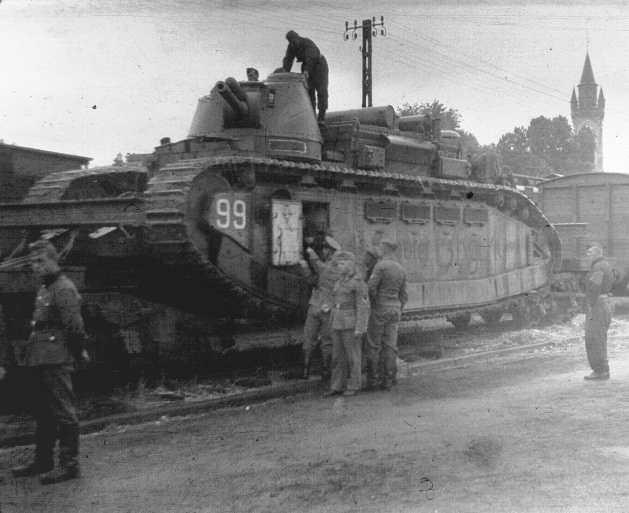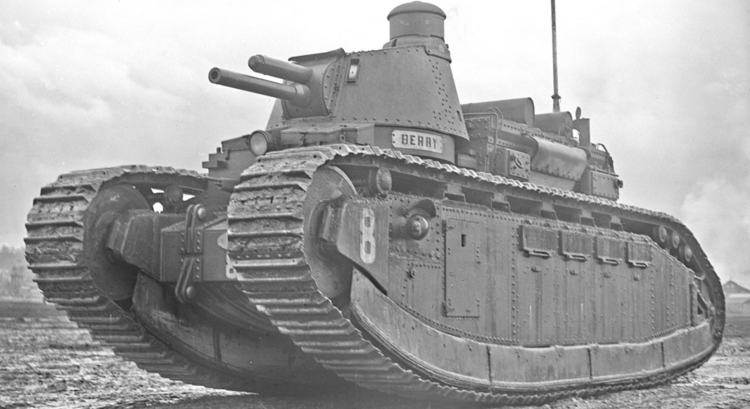Excuse the pun, but this French-built World War I behemoth was once regarded as the heaviest tank ever to see operational service and grace the battlefield. Its fate of becoming an absolute monster on the ground, however, was relatively short-lived, as development and production began near the end of World War I, while newer, more advanced tanks outclassed some of the limited models that made it into service during World War II.
After witnessing the impact of the British-built rhomboid tanks in 1916, the French Army sought to design and create their own. Enter two French Generals: General Jean Baptiste Eugene Estienne and General Léon Augustin Jean Marie Mourret, regarded as the pioneers of the “Char de Rupture” or simply, Char. Both have previously worked on other tank projects, which at one point made them compete for building contracts. Competition aside, Estienne and Mourret eventually came together, brainstormed lessons learned from their previous tanks, and worked on to conceived the FCM 1A prototype. The 1A underwent multiple redesigning and upgrades between 1916 to 1918. Nonetheless, it still didn’t make it to production. Only the largest version was approved for mass production, the 2C, albeit limited.
Char 2C was approved for production in early 1918, but it would take quite a while before it was handed over to the French Army in 1921—three years late for its intended role. Initially, the service ordered 300 tanks, only to be lowered to 100 and eventually to ten units which were the only 2Cs to be commissioned then. These tanks would carry the name of French regions, namely Provence, Picardie, Alsace, Bretagne, Touraine, Anjou, Normandie (weight upgrade to 83 tons), Berry, Champagne, and Poitou. Another later version would emerge based on Champagne, the Char 2C bis, mounting a 155mm main gun, cast turret, and new engines.

Each tank measured overall dimensions of 10.27 x 3 x 4.10 m (33.69 x 9.84 x 13.45 ft) with a whopping weight of 69-ton, the largest and heaviest ever put into production. The thick armor protection of 45mm front, 22mm sides, 35mm frontal turret, 22mm rear turret, 13mm roof armor, and 10mm belly armor contributed most of its weight. This armor would have been impenetrable against small arms and heavy machine gun fires in that period. Had production started a few years earlier, the 2C likely played a pivotal role in “traversing the hellscape that was no man’s land“ with its thick armor and maneuverability through holes, mud, and impressive trench crossing that could have covered on-foot troops. Although, its drawbacks remained like its predecessors, which was its inability to turn effectively. Another shortcoming common to super-heavy tanks was their transportation, given their massive size and weight. Accordingly, one 2C has to be carried by special-made two-piece railcars that will take up to four hours to load and four 39-ton hydraulic jacks and robust dunnage. Different from the Panzer Maus VIII, however, the French behemoth does not need to be disassembled and assembled, but it doesn’t mean that the whole transportation process could have been more timely and tedious.
It is powered by two Daimler or Maybach six-cylinder gasoline engines capable of generating up to 520 horsepower. It could hit a maximum speed of 12 km/h (7.5 mph) within a 100 km (62.1 mi) range.
Classified as a “super-heavy tank,” an FCM 2C can accommodate 12-13 crew, including a driver, four machine gunners, a loader, a main gunner, a mechanic, an electrician, and an assistant of either mechanic/electrician. A standard 2C featured a single 75mm main gun along with four 8x50mmR Hotchkiss machine guns as secondary for anti-infantry defense. The remaining machine guns were strategically mounted in the front, rear, and sides to cover every nook and cranny of the tank. Moreover, according to reports, the 2C could carry up to 124 75mm shells, and more than 9,000 8x50mmR Lebel rounds to load these guns during combat.
Despite not seeing action in WW1, the Char 2C had been active long enough in service that it managed to see through Germany’s eventual invasion of France at the dawn of WW2. However, by this time, tank technology has already advanced. The once breakthrough features of 2C have become outdated compared to the newer tanks manufactured by the Germans. Even its boasted thick armor became a standard and common to most of the tanks in the Second World War, losing its impenetrable capability against enhanced anti-tank guns. This eventual weakness didn’t stop the super-heavy tank from charging on and fighting side-by-side with the French Army in the Battle of France in the late 1930s to early 1940s.

According to a blog by Military Factory, all ten 2C tanks were “purposely destroyed by French forces when the railway the tanks were transported on” was met with heavy fire. The Germans took advantage of the loss of the tanks, symbolizing ground superiority for the French, and blasted the obliteration of the 2Cs as propaganda to demoralize its enemies.
Could it outpower the American Abrams had it made it well into the 21st Century? Obviously, no. Unlike its older generation counterparts, the M1 Abrams really had the advantage of newer technology at its disposal, as well as notes learned from predecessors’ weaknesses and shortcomings that made it the dreadful monster it is today. Yes, Char 2C might be relatively bigger and larger than the American tank, but Abrams has an improved maneuverability that could easily strike 2C even before the latter realizes what’s coming. Even if the earlier version of the M1 met 2C, it would still be a no-brainer win for the former.










COMMENTS
You must become a subscriber or login to view or post comments on this article.